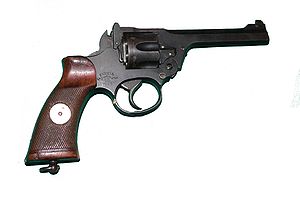| Enfield No.2 Mk I* Revolver | |
|---|---|
 An Enfield No.2 Mk I* manufactured in 1940 | |
| Type | Service revolver |
| Place of origin | United Kingdom |
| Service history | |
| In service | 1932–1963 |
| Used by | United Kingdom & Colonies British Commonwealth other countries |
| Wars | World War II Indonesian National Revolution Malayan Emergency Korean War British colonial conflicts Northern Campaign Border Campaign The Troubles |
| Production history | |
| Designer | Royal Small Arms Factory, Webley & Scott |
| Designed | 1928 |
| Manufacturer | RSAF Enfield |
| Produced | 1932–1957 |
| No. built | approx 55,000 Mk I & approx 270,000 Mk I* & Mk I** |
| Variants | Enfield No 2 Mk I, Enfield No 2 Mk I*, Enfield No 2 Mk I** |
| Specifications | |
| Mass | 1.7 lb (765 g), unloaded |
| Length | 10.25 in (260 mm) |
| Barrel length | 5.03 in (127 mm) |
| Cartridge | .380" Revolver Mk I or Mk IIz |
| Calibre | 0.38 inch (9.65 mm) |
| Action | Double-action revolver (Mk I single/double action, Mk I* and Mk I** double action only) |
| Rate of fire | 20–30 rounds/minute |
| Muzzle velocity | 620 ft/s (189 m/s) |
| Effective firing range | 15 yards (13.7 m) |
| Maximum firing range | 200 yd (182.8 m) |
| Feed system | 6-round cylinder |
| Sights | fixed front post and rear notch |
The Enfield No. 2 was a British top-break revolver using the .38 S&W round manufactured from 1930 to 1957. It was the standard British/Commonwealth sidearm in the Second World War, alongside the Webley Mk IV and Smith & Wesson Victory Model revolvers chambered in the same calibre. Note that in the context of British service revolvers, the .38 S&W cartridge has often been called ".380"[1] (no relation to the common modern .380 ACP pistol cartridge).
- ^ Stamps, Mark, and Ian Skennerton, .380 Enfield Revolver No. 2, page 11.